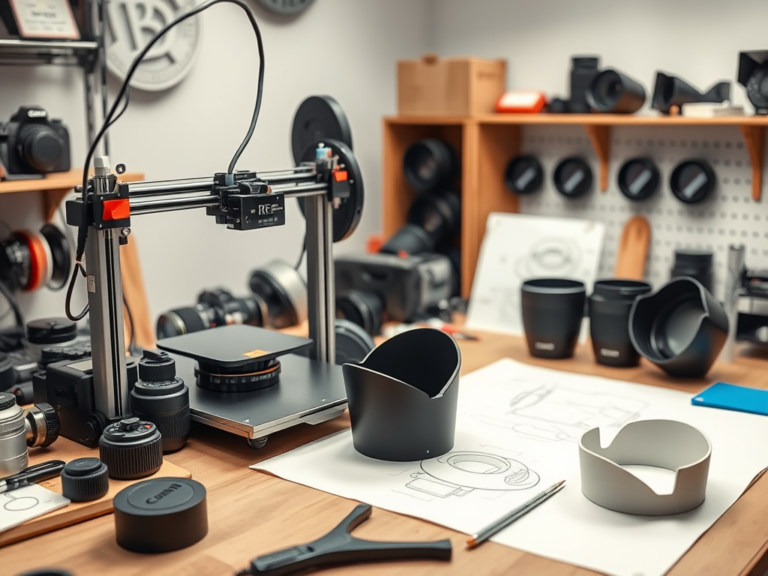
Within the field of photography, lens hoods are crucial in improving image quality by reducing lens flare. Thanks to 3d printing technology, photographers, especially those using Canon’s RF mount lenses, now have the chance to manufacture customised lens hoods fit for their unique purposes. This paper explores the advantages, design issues, and practical actions required to produce 3d-printed lens hoods for RF-mount lenses, offering helpful advice for photography enthusiasts.

Guide for Making a 3D-Printed Lens Hood for RF Mount Lenses
- Create the Model by Design: Create a lens hood design fit for your particular RF mount lens using 3D modelling tools. Guarantee correct measurements for a suitable fit.
- Select the Appropriate Material: Choose a filament that is dependable and strong. A popular choice due to its strength and simplicity of use is PLA+.
- Print the Lens Hood: Create the hood using a 3D printer, making sure the printer settings are ideal for the selected material.
- Post-Processing: After printing, remove any support structures and soften any sharp edges. Further reducing reflections is possible by applying a matte finish or incorporating flocking material into the hood.
- Test Fit and Functionality: To guarantee a good fit, attach the hood to your lens. Test photos will help you to confirm that the hood efficiently lowers lens flare without vignetting.
Approved Sites for 3D-Printed Lens Hood Designs
- Yeggi: Search engine for 3D printable models with several designs for Canon RF lens hoods.
- Thingiverse: A venue for a range of user-generated 3D designs, including customisable lens hoods.
- Cults: Online 3D model repository for different lens hood designs fit for Canon RF lenses.
Advantages of 3d-printed lens hoods
- Economic Worth: Commercial lens hoods can be costly. A cheap substitute, 3D printing lets photographers create lens hoods at a tenth of the cost. For the RF 35mm f/1.8 lens, for example, a user claimed to have built a lens hood for just $0.51, compared to the $45 official Canon EW-52 hood price.
- Customising: 3D printing lets lens hoods fit particular shooting needs. Hoods can be designed by photographers with unusual forms, sizes, and features to fit their specific tastes and shooting approach.
- Availability: For lenses without easily accessible or reasonably priced hoods, 3D printing offers a workable alternative so photographers may quickly outfit their lenses with required attachments.
3D-Printed Lens Hood Design Issues
- Selecting Materials: Choosing the correct filament is crucial. Materials that are easy to print and durable include PLA+. Noting its success, one photographer printed a lens hood using Sunlu PLA+ 2.0.
- Comfort and Compatibility: Crucially, you want a tight and safe fit. Perfect designs will enable the hood to secure fast to the lens without damaging or loosening it too much. Specific designs have reversible elements, which makes handy storage possible when not in use.
- Surface Treatment: Use matte black paint or a flocked finish inside to reduce internal reflections. This improves the hood’s ability to minimise lens flare. Certain 3d-printed hoods include pre-installed flock material inside, which is removable as needed.
READ MORE – Transforming Tradition: The Rise of 3d-Printed Electric Violas in Modern Music
FAQs:
1. Does using a 3d-printed lens hood on my Canon RF lens seem safe?
Yes, given the hood is printed using appropriate materials and designed precisely. Make sure the hood fits tightly without ruining the lens.
2. What materials are needed for three-dimensional printing a lens hood?
Because of its simplicity of printing and durability, PLA+ is widely utilised. One could also consider other materials, like PETG, for higher strength.
3. Can I personalise my lens hood’s look?
Totally. Complete customisation made possible by 3D printing helps you to construct a hood that satisfies your particular needs and aesthetic taste.
4. Where might I obtain pre-made 3D models of Canon RF lens hoods?
Download and print a broad variety of pre-designed models available on websites, including Yeggi, Thingiverse, and Cults.
5. Are 3d-printed lens hoods as good as ones made by manufacturers?
Correct design and printing allow 3d-printed lens hoods to efficiently reduce lens flare and offer physical protection, performing quite like manufacturer-made counterparts.
Conclusion:
3D printing technology has enabled photographers to produce unique, reasonably priced lens hoods for Canon RF mount lenses. Create a valuable and robust lens hood that enhances your photographic experience by considering key elements, including material selection, design correctness, and suitable post-processing. Adopting this do-it-yourself strategy not only has pragmatic advantages but also lets you express creativity in your photo work.